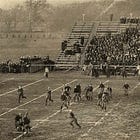Today's Tidbit... Wabash and Kent Lambert's Forward Pass Innovations
You never know where an innovation might arise, but football's history is filled with players and coaches who identified gaps in the rules and used them to their advantage. Two innovations came at the hand of Kent "Skeet" Lambert, who played for the Wabash College Little Giants, finishing his career in 1912.
Lambert played under Jess Harper, the former Chicago player who left Wabash after the 1912 season to take over at Notre Dame. His first year in South Bend was Knute Rockne and Gus Dorais' senior year, and Rockne would take over for Harper when he left after the 1917 season.
As the coach at Wabash, Harper used the forward pass extensively, unlike most teams at the time. The Little Giants had a few tricks up their sleeves when they headed upstate to take on Notre Dame in the battle for the Indiana small college title. It is unclear whether Jess Harper or Kent Lambert conceived these tricks, but one or the other did so and Lambert executed them. Unfortunately, their tricks were not enough as the Irish scored 21 fourth-quarter points to win 41-6.
Nevertheless, Notre Dame, Rockne, and Dorais took notice and adopted the tricks as their own. Walter Eckersall, the former Chicago quarterback, also noticed the Wabash tricks since he happened to referee the game. The following week, he wrote about them in his job as a reporter for the Chicago Tribune.
Lambert's first trick resulted from Notre Dame being a heavier team, so the Little Giants often relied on the forward pass. As Eckersall described the situation, Wabash's passing attack started in punt formation with the ball snapped to Lambert standing 8 to 10 yards behind the center. He then rolled to one side or another, backing up as needed to avoid the Irish pass rush. If Notre Dame defenders came near Lambert, he threw the ball into the ground several yards forward, a tactic that became known as intentional grounding. As best as anyone can tell, Lambert was the first to use this tactic but not the last, especially once word spread after Eckersall publicized it.
The second trick resulted from a 1907 rule that turned passes thrown out of bounds into turnovers, with the ball going to the defending team at the spot where the ball went out of bounds. Although the rule was in its sixth year on the books, Harper or Lambert were the first to turn it into an opportunity. Recognizing a punt could be blocked, poorly booted, or returned, Lambert deliberately threw the ball out of bounds and as far downfield as the arm on his 138-pound body would allow. Like the intentional grounding trick, Eckersall's shedding light on it increased its use.
Eckersall saw the tactics as legal but running counter to the spirit of the rules:
Although Lambert must be given credit for his brilliant judgment, these plays are not in accordance with the spirit of the rules, and legislation should be taken against them. There are several teams in the country which are playing just inside the limitations of the rules and it is up to the committee to discourage this practice.
Eckersall, Walter H. 'Wabash Quarter Pulls Pass Trick,' Chicago Tribune, October 30, 1912.
While the rules committee took notice of both issues, they approached them differently. They did not address either issue for 1913, but made intentional grounding illegal in 1914 since it ran counter to the spirit of the rule and did not require skill to intentionally ground the ball. Notre Dame's use of the intentional grounding tactic in its 1913 win at Army also gave it additional publicity.
As it happened, the new rule appeared in the 1914 rule book immediately following the rule concerning passes thrown out of bounds.
On the other hand, the committee thought throwing the ball far downfield required talent, so they did not change the rule, and teams with a strong-armed player or a weak punter continued throwing the ball out of bounds. However, the committee changed its collective mind in 1920 and passes thrown out of bounds became run-of-the-mill incompletions, returning punters to their rightful place in football's pantheon.
I wrote about intentional grounding two years ago, but I did not know the Wabash originated the tactic or that they were also the first to deliberately throw the ball out of bounds.
That story noted that:
Intentional grounding gained a new definition in 1982 when the college game allowed passers to throw the ball out of bounds to stop the clock, while "spiking" the ball became legal in 1990.
Intentional grounding is now allowed when the ball is thrown outside the tackle box and beyond the line of scrimmage, so we've come full circle on the issue. One can only hope that today's Wabash Little Giants quarterbacks give thanks to Kent Lambert every time they intentionally ground the ball as a DePauw defender approaches in the annual Monon Bell game.
Click here for options on how to support this site beyond a free subscription.





